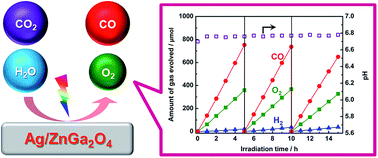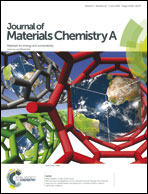Highly efficient photocatalytic conversion of CO2 into solid CO using H2O as a reductant over Ag-modified ZnGa2O4†
Abstract
Highly crystalline spinel phase ZnGa2O4 modified with a Ag cocatalyst exhibited high activity and selectivity toward CO evolution in the photocatalytic conversion of CO2 using H2O as a reductant under UV light irradiation. The stoichiometric evolution of CO, H2, and O2 clearly indicated that H2O worked as an electron donor for the photoreduction of CO2. Highly crystalline ZnGa2O4 was synthesized by a solid-state reaction method at a calcination temperature as low as 973 K. Upon optimizing the fabrication conditions, such as calcination temperature and duration, the photocatalytic activity of ZnGa2O4 was maximized because of the optimum balance between crystallinity and surface area in the catalyst material. Furthermore, the formation of metallic Ag particles with different sizes and dispersions on the surface of ZnGa2O4 influenced the evolution of CO. When Ag nanoparticles were loaded onto the ZnGa2O4 calcined at 1123 K for 40 h using a chemical reduction method, the highest formation rates of CO, H2, and O2 (155, 8.5, and 74.3 μmol h−1, respectively) were obtained, and the selectivity toward CO evolution reached 95.0%. An isotope-labeling experiment using 13CO2 confirmed that the origin of the evolved CO was not from organic contamination but from the CO2 gas introduced during the reaction process.


 Please wait while we load your content...
Please wait while we load your content...